Blog categories
Blog archive
RSS Blog posts tagged with 'tips'
Blog Filters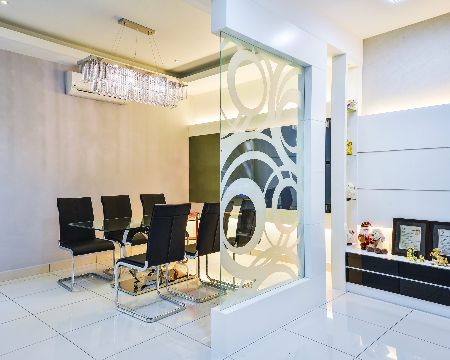
Minimal Mode: 5 Minimalist Dining Rooms to Inspire You
Friday, November 20, 2020
Minimalist style is a dependable aesthetic to aim for in modern urban homes, but ideas may be limited to Scandinavian furnishings in a neutral palette. To ensure a bit of diversity in everyone's minimalist decor, we took a look at the five most inspirational dining spaces that apply the minimalist aesthetic - and take it for a little walk off the beaten path.
Sleek Finery
The compact proportions of this dining corner are echoed in the narrow profiles of the furnishings and decorations adorning it. To preserve the sense of spaciousness, Space In Design selects a lightweight modern dining table topped with a glass surface and an accompaniment of six thinly-upholstered chairs framed with reflective metal. The dividing wall and adjacent shelving is similarly composed in simplistic style, but while the other elements of the space lean heavily towards simplicity, the central lighting fixture here is an intricate array of crystalline forms for luxurious punctuation.
 Interior design by: Space In Design
Interior design by: Space In Design
Subdued in White
Surface R incorporates restaurant-style banquette seating to transform what was once a walkway into a compact dining space. To diminish the intrusion into the reduced walkway, the accompanying chairs are necessarily composed in minimalistic style - with white mould-injected plastic seats held up on legs of pine and simplistic metal webbing in black. The two separate planes of natural wood in the bench seating and adjacent wall exert additional Scandinavian influence onto the space, while beams painted white form the dividing wall and ceiling canopy, enveloping the arrangement and bolstering the simplistic decor with an air of sunlit elegance.
 Interior design by: Surface R
Interior design by: Surface R
Classical Impressions
Nice Style Refurbishment uses minimalist lines to paint a picture of classical influence in this combined dining and living space. Simplistic moulded panelling line the wall and camouflage the nearby doorway - the distinctly modern cuts of wood taking after the traditional use of wainscoting to frame paintings hung on walls. A country-styled dining table and accompanying chairs create an ambiance of rural luxury in combination with the classical chandelier and the button-back upholstery in the adjacent seating lounge.
 Interior design by: Nice Style Refurbishment
Interior design by: Nice Style Refurbishment
Country Lite
While countryside style may be ordinarily achieved with heavily-adorned furnishings in pastel shades, Nu Infinity demonstrates that minimalist furniture composed of wood can be called upon to create an assembly to seemingly transport a minimalist dining space to a rural setting. In a playful diversion from the expected neutral palette, lime green is used to evoke imagery of nature in the thin padding of the dining chairs.
 Interior design by: Nu Infinity
Interior design by: Nu Infinity
Rustic Industrial
Yong Studio achieves a decor balanced on a fine point between the lightweight aesthetics of a minimalist dining space, sombre shades of wood, and modern industrial influence in the prevalent use of metal frames in black. While the dining table is a robust slice of a tree trunk held up on thick square pipe legs, the accompanying chairs are kept as thin as possible to reduce the imposition on the the space's central feature.
 Interior design by: Yong Studio
Interior design by: Yong Studio
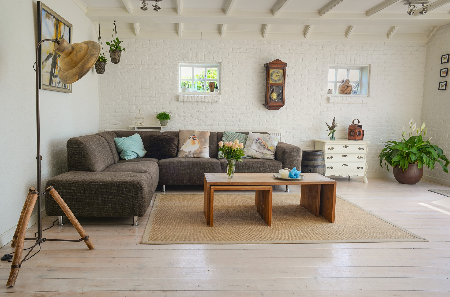
Zen Den: 8 Tips for Cultivating a Calm Atmosphere at Home
Friday, November 20, 2020
We spend many hours in our home. It’s where the day is started and sealed. It should be a place that fosters relief after the many to-dos and ventures of a day. Make the most of time at home by cultivating a relaxing, calm living space for yourself, your family, and your friends and guests. Whether in the living room, family room, bedroom, or other space, there are many small steps you can take to promote peace in the home. Follow these eight tips to transform home into a place you want to spend time in and relax in: 1. Give Everything a “Home” Having clutter on table tops, floors, and elsewhere can translate to feeling cluttered throughout your life. Make sure that your important things, like those needed on a daily basis (keys, for example), have a space that is easily accessible but not immediately visible. This will alleviate the sense of visual clutter. Keep doorways clear and items off and out of the spaces used for sitting and relaxing!
2. Set Atmosphere With Music
Having clutter on table tops, floors, and elsewhere can translate to feeling cluttered throughout your life. Make sure that your important things, like those needed on a daily basis (keys, for example), have a space that is easily accessible but not immediately visible. This will alleviate the sense of visual clutter. Keep doorways clear and items off and out of the spaces used for sitting and relaxing!
2. Set Atmosphere With Music
 Consider purchasing a portable speaker to connect to your phone, or set up a music streaming service on your TV for playing background music. Choose calming songs like instrumental soundtracks and classical pieces. Keep the sound low so you can hear the music but not too loud that people have to talk over the music.
3. Bring the Outdoors In
Consider purchasing a portable speaker to connect to your phone, or set up a music streaming service on your TV for playing background music. Choose calming songs like instrumental soundtracks and classical pieces. Keep the sound low so you can hear the music but not too loud that people have to talk over the music.
3. Bring the Outdoors In
 Bring vases of flowers or small plants inside. These provide color and calm. Choosing planters with decorative accents can improve the energy of a space as well. Live plants will clean the air and will not gather dust. The smell and life of indoor plants connects us with the outdoors, satisfying a fundamental human need for interaction with nature.
4. Let Light Shine
Bring vases of flowers or small plants inside. These provide color and calm. Choosing planters with decorative accents can improve the energy of a space as well. Live plants will clean the air and will not gather dust. The smell and life of indoor plants connects us with the outdoors, satisfying a fundamental human need for interaction with nature.
4. Let Light Shine
 Open windows, blinds, and drapes to permit sunlight to come in. Natural light will brighten the space, will help regulate hormones during the day, and will make the space feel bigger and cleaner, which has an instantly calming effect. Exposure to natural light is important for maintaining circadian rhythm, so allowing it into the home has health benefits. Reflective surfaces, such as mirrors and clean spaces, can make your space even brighter and feel bigger.
5. Freshen Up
Open windows, blinds, and drapes to permit sunlight to come in. Natural light will brighten the space, will help regulate hormones during the day, and will make the space feel bigger and cleaner, which has an instantly calming effect. Exposure to natural light is important for maintaining circadian rhythm, so allowing it into the home has health benefits. Reflective surfaces, such as mirrors and clean spaces, can make your space even brighter and feel bigger.
5. Freshen Up
 Consider opening windows to bring in natural air. Plug in light air fresheners or burn a scented candle to plant fresh smells inside. Essential oils, aromatherapy, or room sprays may also help temper the atmosphere. Use smells that have a calming or cleaning effect, such as lavender or lemon. Dusting down surfaces will help maintain a neat appearance.
6. Paint With Light or Neutral Colors
Consider opening windows to bring in natural air. Plug in light air fresheners or burn a scented candle to plant fresh smells inside. Essential oils, aromatherapy, or room sprays may also help temper the atmosphere. Use smells that have a calming or cleaning effect, such as lavender or lemon. Dusting down surfaces will help maintain a neat appearance.
6. Paint With Light or Neutral Colors
 Avoid bright statement walls or overly energizing colors like bright red and blue. Don't clutter walls with tons of pictures, photos, or frames. Instead, paint the walls with muted colors, neutral colors, or your favorite relaxing blend of colors. Leave the bright colors to accent pieces or items for display. Consider one or two larger focal pictures or an interesting piece of art to draw attention to a few central points in the room to avoid overstimulation.
7. Prepare for All Temperatures
Avoid bright statement walls or overly energizing colors like bright red and blue. Don't clutter walls with tons of pictures, photos, or frames. Instead, paint the walls with muted colors, neutral colors, or your favorite relaxing blend of colors. Leave the bright colors to accent pieces or items for display. Consider one or two larger focal pictures or an interesting piece of art to draw attention to a few central points in the room to avoid overstimulation.
7. Prepare for All Temperatures
 Have pillows and blankets available for snuggling up on your favorite couch or chair. Have a couple blankets for warmth and ensure that they have different thicknesses and textures so you have "just right" warmth no matter the weather or room temperature. Blanket and pillows are also great for providing texture in the home and can add a sense of calming aesthetic interest wherever they are displayed.
8. Keep Your Favorite Things in View
Have pillows and blankets available for snuggling up on your favorite couch or chair. Have a couple blankets for warmth and ensure that they have different thicknesses and textures so you have "just right" warmth no matter the weather or room temperature. Blanket and pillows are also great for providing texture in the home and can add a sense of calming aesthetic interest wherever they are displayed.
8. Keep Your Favorite Things in View
 While it is typically good to avoid overcrowding a space, having your favorite books, magazines, or photos out of the things you love and favorite memories can add positivity and comfort to the room. Keep out only those keepsakes that have special value to you. Use these to keep you calm during your relaxing time, refresh your memories, or motivate you for your next adventure.
Consider these steps as you clean and renovate your home. Keeping your space calm and reflective of your values and personality will transform your home into a place of restoration and peace, which is the best possible effect it could have!
Article courtesy of Olivia Warfield, a contributing writer and media relations specialist for Atlas Heating & Air Service. She writes for a variety of DIY and lifestyle blogs.
While it is typically good to avoid overcrowding a space, having your favorite books, magazines, or photos out of the things you love and favorite memories can add positivity and comfort to the room. Keep out only those keepsakes that have special value to you. Use these to keep you calm during your relaxing time, refresh your memories, or motivate you for your next adventure.
Consider these steps as you clean and renovate your home. Keeping your space calm and reflective of your values and personality will transform your home into a place of restoration and peace, which is the best possible effect it could have!
Article courtesy of Olivia Warfield, a contributing writer and media relations specialist for Atlas Heating & Air Service. She writes for a variety of DIY and lifestyle blogs.
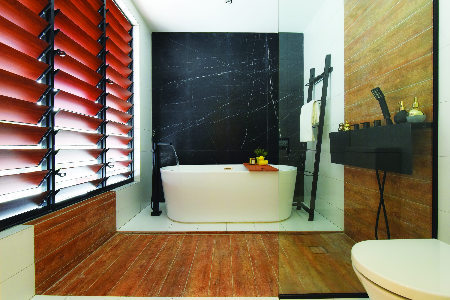
Bath Beauty: 5 Contemporary Bathroom Trends
Friday, November 20, 2020
There are not many bathrooms deserving of a long-lasting memory, and while some are easily forgettable spaces, there are bathrooms in existence that remain in mind long after they have been seen. This time around, we take a look at the five most memorable bathrooms we have seen recently, to attempt a breakdown of what makes these largely neutral-coloured spaces spectacular.1. Vintage Lines
 Interior design by: Yong Studio
Interior design by: Yong Studio
The windows of a previous era are updated for the present times with the glass panes exchanged for pieces of wood, the horizontal lines repeated in a border that simultaneously serves as the footprint of the shower's partial enclosure and separates the modern freestanding bathtub from the rest of the bathroom. The deliberate selection of fixtures powder coated in carbon is echoed in the architectural considerations: the black pipe window frames and a panel of Nero Marquina providing the basis for the monochromatic palette.
2. Solemn Grace
 Interior design by: Fix Interior
Interior design by: Fix Interior
The monochrome fixtures and countertop of this bathroom are elegantly framed in grey and cream tiles that have been laid in a standard grid arrangement. The somber ambience is enlivened with gilded portrait frames and warm yellow lighting, contributing to a golden glow that is reflected across the space to bridge the gap between the monochromatic fixtures and neutral architectural finishes.
3. Sunlit Decadence
 Interior design by: Nu Infinity
Interior design by: Nu Infinity
A monochromatic palette is applied to redefine the modern luxury of a sunlit bath - with a freestanding tub resting in the centre of a glass-enclosed air well, framed in black square pipe and smooth matte black tiles. Serving as both a practical consideration and as a tropical element to counter the decidedly modern decor, dark wood is incorporated into a deck floor beneath the tub.
4. Natural Accents
 Interior design by: X-Dimension Design
Interior design by: X-Dimension Design
In a space decked with black and grey stone, a few limited flourishes with pale wood serve to alleviate the seriousness of the decor. Wood is utilised in the shelving and mounting background for the mirror to add warming layers to the coldness of a counter tiled in black stone.
5. Rustic Vibe
 Interior design by: Yong Studio
Interior design by: Yong Studio
With just a few splashes of natural materials, such as the addition of wood and wicker weave, this largely white bathroom is gifted a mature and warm personality that would have been absent in the face of the white walls and grey floor tiles. The modern pendant lights hanging from the ceiling in the corner exude an inviting glow in conjunction with the vertical wood pieces on the wall - the decorative feature deliberately extended to affect the light on more than one plane.
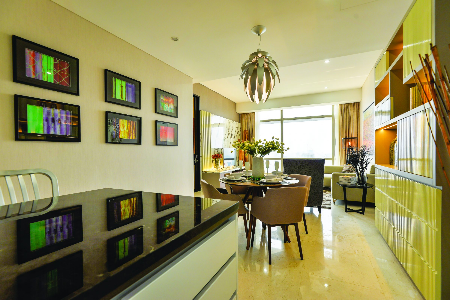
10 Ideas for Combining Your Dining and Living Spaces
Friday, November 20, 2020
Beyond just arranging dining and living room furniture sets near each other, there are a host of other considerations that one should look into when combining these two functionally separate areas.
 Interior design by: Kuzoj
Interior design by: Kuzoj
With space at a premium in urban homes, combining two of the areas that often take up the most space is a practical way of freeing up room for other functions. But things can get a little busy and cluttered when combining dining and living areas in small spaces such as a studio apartment or a home with an open floor plan. In light of the many ways that this merging can be achieved, we took a look at the most notable combined spaces we have seen over the years and extracted the base ingredients for your perusal here.
1. Grouped Arrangements
If you have the space to spare in your open plan home, the easiest way to combine the dining room with seating lounge is to position the respective furniture into two separate but adjacent groups - with an empty gap for a walkway between the two groups providing a means of access and to act as subtle demarcation.
 Interior design by: SQFT Space Design Management
Interior design by: SQFT Space Design Management
2. Narrow Spaces
For a comfortable dining experience, diners need between 90cm to 1.3m of space to be able to pull out a chair and take a seat, with around 60cm to 70cm of space between each seat for adequate elbow room. If space is limited, opt for a narrow rectangular table to discretely occupy the space on one side of the seating lounge.
 Interior design by: Pocket Square
Interior design by: Pocket Square
3. Informal Seating
At the most extreme end of the scale, one could also go beyond merging dining and living areas, by having seating and dining table occupy the same space. Replacing chairs on one side of a dining table with an upholstered bench creates a casual setting for meals and enables one to forgo having a sofa set - if the comfort and formality are not to be missed.
 Interior design by: The Roof
Interior design by: The Roof
4. Wall Features
To rein in the surplus empty space in your open plan layout, build up false wall projections and turn them into shelving or see-through niches to provide a means of visual separation as well as a functional fixture for additional storage.
 Interior design by: Beata Home and Office Furnishing
Interior design by: Beata Home and Office Furnishing
5. Decorative Ceilings
Even the thinnest of wall façades will take up some space, if only a negligible amount. To clearly demarcate your combined dining and seating lounge without occupying any of the valuable floor space, consider forming borders on the ceilings to visually indicate the extents of the functionally separate areas.
 Interior design by: Design Base
Interior design by: Design Base
6. Island Bars
Even without a dry kitchen adjacent to the seating lounge, it is possible to incorporate bar-height counters or kitchen islands - along with some stools or chairs of appropriate height, to provide a dining space in close proximity. Opting for countertop dining makes for a casual dining experience, and frees up additional space for other uses, such as a more spacious seating lounge.
 Interior design by: Pins Studio
Interior design by: Pins Studio
 Interior design by: Luna Solutions
Interior design by: Luna Solutions
7. Raised Platforms
With a small measure of additional space in an open floor plan, a slightly raised wooden platform would serve to elevate, highlight, and to keep the dining space visually distinct from any nearby seating.
 Interior design by: Pins Studio
Interior design by: Pins Studio
8. Decorative Archways
Building up a decorative archway between dining and seating furniture is another space-efficient way of define the combined areas, but best results are achieved in wide spaces so as not to make the open floor plan appear cramped.
 Interior design by: D'Concepto Design
Interior design by: D'Concepto Design
9. Dividing Drapery
In lieu of features such as arches, shelving, or see-through niches, an opaque or transparent curtain can be drawn shut to provide a temporary privacy screen during meals, and opened between meals to preserve the spaciousness of the open layout.
 Interior design by: Zids Design
Interior design by: Zids Design
10. Unifying Style
Whatever the means you have chosen to apply in visually indicating the separate functions of your combined dining and seating area, a harmoniously applied decorative style will serve to unify the distinct spaces. A unifying style does not necessarily entail a repeated palette, as a cohesive décor can still be achieved with complementary colour pairs applied as interchangeable base and accent colours.
 Interior design by: Nu Infinity
Interior design by: Nu Infinity

Delectable Hues: Rich Tones of Burgundy and Blue to Warm Up Your Interior Palette
Friday, November 20, 2020
Curtains Place presents a rich palette inspired by warm colour tones in the burgundy and blue range, from colours ranging from deep pink to faded shades of the ever popular purple and intense blues. Adding a warm touch to the interior, the room-high Breeze is the featured fabric in this look with wanderlust leaves in beautiful blend of these warm colours. To complement this look, intense dark hues of blue are the perfect key colour. The use of stronger and darker colours remains a strong trend in interior decoration. Here, the Arezzo collection is featured in the dark denim tone on the chair. Burgundy goes well with a range of blue shades, in particular with equally warm dark hues. The timeless tones of deep navy blue used here evoke warmth and add to the intensity. Together these colours create a cosy elegance.
Burgundy goes well with a range of blue shades, in particular with equally warm dark hues. The timeless tones of deep navy blue used here evoke warmth and add to the intensity. Together these colours create a cosy elegance.
 Styling Tips:
Styling Tips:
- Let navy blue serve as a backdrop for burgundy highlights in your room. Use an accent wall with this colour to add depth.
- Both burgundy and blue look dramatic and decadent in a luxury velvet, chenille or satin fabric. You will also find many complementing tones to combine in accessories with ranges of pinks and purples.
- For a striking curtain choice in burgundy and blue, choose collections that will work well with your theme.
- Add metallic touches to your accessories in gold if you are looking for a more classic and regal look. Antique gold finishes add a great statement to the palette.
- These colours are also great on translucent materials – vases or table tops in these tones add glam to a room.
- You can also soften down the palette with warmer shades of grey with hints of purple in it - a rug in warm grey or combined cushions for example. Alternatively, you can add these rich tones to spice up your grey interiors.
- With these warm colours keep the accessories to the minimum to avoid cluttering.
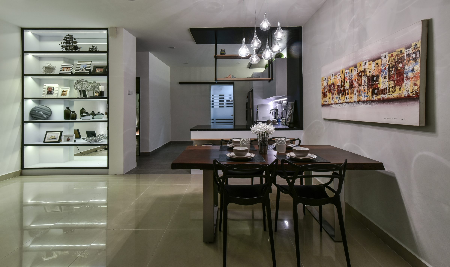
Delectable Walls: 5 Ways to Decorate Your Dining Room Walls
Friday, November 20, 2020
Decorating walls can be so much more than a mere matter of the colour of paint you apply or the school of art you subscribe to, beneath it all is a landscape of subtle considerations in terms of theme, material, and arrangement of elements. If you have the wall space to spare, consider these five ways of decorating your dining room walls to achieve effects ranging from eccentric to elegant.
1. Transposed Landscapes Interior design by: Moonlit Inspiration
Interior design by: Moonlit Inspiration
Evoking high-street galleries and art collectives of post-industrial environements, an unframed canvas introduces a contained burst of colour over a briskly white washed cement wall that serves as the background. The rectangular dimensions of the canvas are repeated in the simplistic black frame of a nearby shelving unit, while the bright display lighting and mirrored back panel contribute to the gallery ambiance.
2. Eclectic Ensemble
 Interior design by: Viincology
Interior design by: Viincology
An arrangement blending imagery evocative of England and times past: a replica of the London Underground’s roundel occupies a prominent position on the nearby wall, the field framed in warm white down-lights while a bench invitingly dotted with throw pillows underscores the arrangement. The adjacent walls host arrays of same-sized, framed motivational prints in the style of vintage advertorial flyers to add a layer of retro vibes to the eccentric décor.
3. Material Contrast
 Interior design by: Q1 Interior Concept
Interior design by: Q1 Interior Concept
The dining furniture sit at a convergence of contrasting themes: one wall bears framed images of river pebbles in their natural environment, the meditative photo prints seemingly suspended on vinyl cut-outs of birch trees. The characteristically long horizontal lines of birch bark are echoed in with reflective metallic accents lining the adjacent wall of peach-coloured stone.
4. Cohesive Display
 Interior Design by: Jashen Interior Design
Interior Design by: Jashen Interior Design
A wide field of brown on the adjacent wall adds a dimension to the monochromatic palette of the dining furniture, visually expanding the space by bridging the gap between the dark upholstery and the pale architectural finishes. An unframed abstract painting occupies the central position on the wall, its dimensions sitting neatly within the frame of the banquette arrangement.
5. Layered Presentation
 Interior design by: KP Property Design Team
Interior design by: KP Property Design Team
The glistening and colour-rich décor of this dining room is contrasted by a white wall, marked by grids with wide borders, serving as the backdrop for a monochromatic product of an ink roller and stencil. The abstract rendering and its simplistic background draw the naïve eye with the contradiction of black and white amidst a burst of colour.

Bathe in Light: 5 Bathroom Lighting Tips to Enliven Your Bathing Space
Friday, November 20, 2020
Lighting for the bathroom is often an afterthought. It's actually important to plan it right so that you can achieve the ambience you want. These five lighting tips for the bathroom will show you how to get lighting up and running beautifully in your bathing space. 1. The Right Lighting Proper and plentiful light in the bathroom has many useful benefits. That includes setting your circadian rhythms that are an important part in over-all health, elevating one's mood, allowing bright illumination for the washing and grooming duties, and more. Most importantly is that it is critical for safety, especially for the elderly or disabled since the bathroom is where 80 percent of falls happen. 2. Minimize Glare
If you are bothered by glare, use fixtures that mask the actual light such as deeply recessed downlights or up-lights or dimmers to make adjustments as needed. Also helpful are tubular fluorescent lights with a frosted lens to reduce the glare.
2. Minimize Glare
If you are bothered by glare, use fixtures that mask the actual light such as deeply recessed downlights or up-lights or dimmers to make adjustments as needed. Also helpful are tubular fluorescent lights with a frosted lens to reduce the glare.
 3. Correct Measurements
Lighting recommended for the dressing area is eye-level provided by fixtures at least 30 inches apart with a minimum of 60 watts. That can be accomplished with chain-hung pendants or wall sconces that provide light on both sides of the face for grooming and applying cosmetics.
3. Correct Measurements
Lighting recommended for the dressing area is eye-level provided by fixtures at least 30 inches apart with a minimum of 60 watts. That can be accomplished with chain-hung pendants or wall sconces that provide light on both sides of the face for grooming and applying cosmetics.
 4. Night Lights
Night lighting is essential to safely maneuver and prevent falls in the middle of the night. Bright overhead lights can be disruptive and blinding when one's eyes are adjusted to darkness. Provide a low-wattage lamp, or one that responds to motion, or create one by illuminating the toe-space area below the vanity with a linear lighting system.
4. Night Lights
Night lighting is essential to safely maneuver and prevent falls in the middle of the night. Bright overhead lights can be disruptive and blinding when one's eyes are adjusted to darkness. Provide a low-wattage lamp, or one that responds to motion, or create one by illuminating the toe-space area below the vanity with a linear lighting system.
 5. Accentuating the Space
A decorative light fixture that is suspended from the ceiling gives any room an elegant touch at the same time that it is adding extra light.
Article courtesy of Patriot LED
5. Accentuating the Space
A decorative light fixture that is suspended from the ceiling gives any room an elegant touch at the same time that it is adding extra light.
Article courtesy of Patriot LED
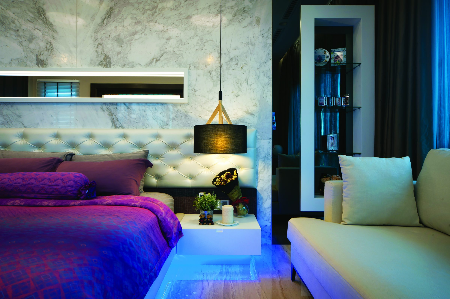
How to Make Your Bedroom Unique
Friday, November 20, 2020
While the ground floors of most homes typically exhibit the public facets of a homeowner’s personality, it is in private spaces—such as the bedroom, where the soul can truly shine unhindered by protocol and social norms.
Some might be willing to call it a day after putting in a bed, a closet, and a pair of matching bedside tables, but others may not be satisfied unless the bedroom is rendered memorable and awe-inspiring. Variety being the spice of life, we take a closer look at some intriguing bedrooms in order to outline the kind of tweaks that can set one’s bedroom apart from all others.
Levitating Platforms
Light is an understated and crucial component in visual compositions ranging from paintings to film, with its rendering being of such importance that entire careers are built around the study and application of lighting. Perhaps one of the easiest ways of differentiating a bedroom would be to add an intriguing lighting fixture and to let the wash of light paint the space in unique ways. Among the simplest and most dramatic displays of light we have encountered is demonstrated with Luna Solutions’ treatment of the pictured bedroom.
Design Spirits demonstrates this uplifting effect of lighting in combination with more opulent materials in the bedroom pictured below. Against a background of seamless marbled stone on the floors and on the walls, the designers incorporate a strip of cold blue LED lighting around the the lower lip of the bed frame and the adjoining bedside surfaces. The resulting effect is the entire bed platform appearing to float on a magical sheen that echoes the quality of daylight filtered through the blue drapery.
 Interior design by: Design Spirits
Interior design by: Design Spirits
Zen Influence
 Interior design by: Mode Interior
Interior design by: Mode Interior
In the wake of minimalism follows the pursuit of Zen aesthetics—which is essentially the effort to create serenity from simplicity. The influence of Japanese practicality and tatami flooring leads to an intriguing bed platform as designed by Mode Interior in the pictured bedroom. Applied in combination with lighting along the floor, a theme of cosmic exploration, and futuristic curves, this bedroom uniquely straddles the divide between the aesthetics of the past and the future.
Functional Partitions
 Interior design by: Luna Solutions
As Dwight “Ike” Eisenhower once said: “Plans are nothing; planning is everything.” While most of the houses on the block may feature very similarly sized spaces by way of a repeated plan, Luna Solutions renders this bedroom unique with practical space planning. A partition of carbonised steel and glass panels is raised from the wood floor of this bedroom to subdivide the space, providing adequate space for access to the bed in addition to an avenue for a walk-in wardrobe on the other side.
Interior design by: Luna Solutions
As Dwight “Ike” Eisenhower once said: “Plans are nothing; planning is everything.” While most of the houses on the block may feature very similarly sized spaces by way of a repeated plan, Luna Solutions renders this bedroom unique with practical space planning. A partition of carbonised steel and glass panels is raised from the wood floor of this bedroom to subdivide the space, providing adequate space for access to the bed in addition to an avenue for a walk-in wardrobe on the other side.
Futuristic Mode
 Mode Interior takes opulent slabs of marble and applies them in angular cuts to the wall of the pictured bedroom, backlighting the panels with hidden sources of illumination to create a decorative feature that seemingly draws inspiration from designs portrayed in science fiction. Interior design by: Mode Interior Style
Mode Interior takes opulent slabs of marble and applies them in angular cuts to the wall of the pictured bedroom, backlighting the panels with hidden sources of illumination to create a decorative feature that seemingly draws inspiration from designs portrayed in science fiction. Interior design by: Mode Interior Style
The attraction of following within the confines of known decorative styles is a result that is instantly recognisable and attributable to a particular school of aesthetics: classicism denotes opulent formality, while minimalism entails functional simplicity. Aside from experimenting with blends of defined styles, one other route of differentiation would be to take the avant-garde approach in the bedroom—to paraphrase the words of some fictional spacefarers—to boldly go where no one else has gone before.
 A partition and television wall composed of white marble rises from the floor, containing the bed within a comforting berth of stone.
[gallery columns="2" size="medium" ids="58326,58327"]
A partition and television wall composed of white marble rises from the floor, containing the bed within a comforting berth of stone.
[gallery columns="2" size="medium" ids="58326,58327"]
The futuristic theme is extended to the workstation on the other side of the partition, with slats running along the ceiling—an acoustic and thermal consideration shaped in the manner of a ship’s ribbing.
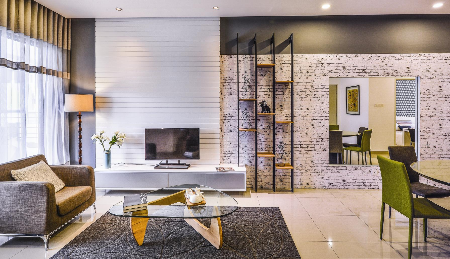
Choosing Your Living Room Furniture
Friday, November 20, 2020
Before setting out on your journey of acquiring living room furniture, consider the function, size, orientation, and shape of the space - then the style, material, and colour of your furnishings.
Filling any blank canvas requires the poise and confidence of an accomplished artist, but there is so much more than one's creative pride at stake when it comes to the kind of space that imparts first impressions like the average living room does. There are minimalist furnishings that may render a large space empty, there are button-backed leather Chesterfields that can overwhelm an urban apartment, and then there are modern contemporary sofas that seem to fit anywhere.
 Image Credit: Design Base
Image Credit: Design Base
With all the available sizes and styles of furnishings available, you may find yourself hard pressed to assemble a cohesive arrangement with varied pieces from different manufacturers. Armed with this guide and the critical considerations it presents, we believe your next search for living room furniture will produce more effective results.
Function
The first thing to do before furnishing any space is to pose the question of what one intends to do with it. Is your home a hub for large clan gatherings or more likely reserved for a select few? The approaches to furnishing your living room would differ depending on whether you are assembling a bachelor pad hangout or a lounge for a large family - the latter typically requires more seating, including the requisite pair of matching armchairs for the matriarch and patriarch of the clan, while the former could be adequately furnished with a single sofa set in close proximity to a coffee table.
 Interior design by: Q1 Interior Concept
Interior design by: Q1 Interior Concept
Size
With the role of the living room decided, one would have to take a look at what space there is to work with. In addition to floor space, one should also consider the presence and height of walls demarcating the area. First of all, is the lounge part of an open plan concept or is it enclosed in walls? A room surrounded by walls limits ingress and egress options, making arrangements more dependant on the placement of walls - on the other hand, an open layout leaves more to the imagination.
 Interior design by: The Home Concept Furniture
Interior design by: The Home Concept Furniture
Secondly, does the height of the ceiling make for a double volume space? A double-height ceiling will enable the incorporation of furnishings with high profiles to take advantage of the extra airspace, while a conventional ceiling may require furnishings of lower height so as to not overwhelm the sense of volume.
Lastly, what is the traffic flow around the house going to look like? If the living room is located more at the core of the house, walkways between furnishings would have to be considered, less so if it is a secluded corner.
 Interior design by: The Roof Studio
Interior design by: The Roof Studio
Shape
In addition to the size of the living room, the shape of a space will have an effect on the furnishings you select. An especially long and narrow lounge may not benefit from many round furnishings placed in the centre, while a square room will appear rather empty with the majority of furnishings hugging the walls.
 Interior design by: ID Industries
Interior design by: ID Industries
There exists a number appearing in both natural and produced designs that have been found to be aesthetically pleasing since the Italian Renaissance - the golden ratio of 1.618 has often been used to produce compositions that are universally regarded as beautiful. Applying this ratio to your own compositions will almost certainly guarantee an appealing arrangement: if you have an especially long space, consider visually subdividing it with pieces of seating or table surfaces to achieve a space where the length divided by width produces a number approaching the golden ratio.
Orientation
Another factor with significant weight on the effect of your furnishings is the orientation of the space, which affects the amount of sunlight your living room receives as the sun transits across the sky during the day. Material choices for your furnishings could be swayed by varying levels of sunlight at different times of day, so we recommend keeping a few sample swatches around to compare before settling on a material. Coupled with the consideration of natural lighting is the presence of windows providing scenic views - furnishings with low profiles may be considered to preserve the view, while high-backed seating could be made less intrusive by being positioned against a wall.
 Interior design by: The Roof Studio
Interior design by: The Roof Studio
Style
Prior considerations with regard to the function, size, shape, and orientation of the living room are less controllable - but the choice of style for your furnishings is where your personality will be more obviously presented. Before settling on your choice of furnishings, decide on whether you want your living room to be dedicated to the hallmarks of particular styles, such as the traditional trappings of classical style or dispense with all the frills for a minimalist decor - or maybe you would want to consider putting together your own unique assembly to present a more eccentric image.
 Interior design by: The Home Concept Furniture
Interior design by: The Home Concept Furniture
Materials
The choice of material for your furnishing is largely dependant on the function of the space, the lighting levels, and the style you want to achieve. Metal and wood frames are compatible with a wide range of styles, with reflective surfaces being more suited for spaces with a modern lean. Suede and fabric upholstery may be delectable to the senses, but tougher materials like leather may be more suitable in homes with children or pets.
 Interior design by: Surface R
Interior design by: Surface R
Colour
It probably goes without saying that the shades and tones of your living room furniture should be selected according to your personal preference, albeit with attention paid to the subtle effects of colour on moods, the appearance of colours in changing light conditions, and matching or complementing furnishings with the base or accent colours in architectural finishes.
 Interior design by: X-Two Concept
Interior design by: X-Two Concept
Completely saturating a room in various shades of a single colour is an easy way to get around most of the additional considerations of matching or complementing with base or accent colours, while imposing into a space a favoured hue and its effects on mood.
 Interior design by: Gusto Design & Build
Interior design by: Gusto Design & Build
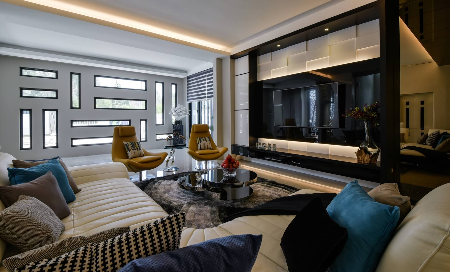
7 Ways to Make Your Living Room Unique
Friday, November 20, 2020
Great minds may think alike but few actually enjoy being the unwitting character in the trope of two party guests dressed the same. If you’ve ever experienced a disorientating wash of déjà vu when stepping into someone else’s living room, you may be interested in finding ways of differentiating your own space. In this guide, we take a look at the various avenues for creating uniqueness in your seating lounge.
Feature Walls
 Interior design by: GDY Design
Interior design by: GDY Design
Unless every piece of furniture is individually manufactured to your specific tastes, there’s a chance that the arrangement of your living room is similarly, if not identically, represented in someone else’s home. To differentiate the pictured seating lounge, GDY Design & Construction apply their creative impulses to the surrounding walls by relying only on a monochromatic palette and a simplistic brick motif. With the walls rendered unique, their efforts encapsulate the furniture arrangement in an environment that could only be duplicated with access to the designer's schematics.
High Ceilings
 Interior design by: Desigva Interior
Interior design by: Desigva Interior
Just as the oculus—the circular skylight at the apex of the Pantheon’s dome in Rome—has provided pilgrims and curious sightseers with spiritual experiences for over a millennium, an extra-height ceiling or an air-well appointed with generous windows and skylights will create entry points for sunlight. As the quality of sunlight varies over the course of the day, the tones of the pictured seating lounge are highlighted in various unique ways: the warm and ethereal light of sunrise and sunset accentuates the darker colours, while the brightness of midday emphasises the white background.
Aquascaping
 Interior design by: ID Industries
Interior design by: ID Industries
Beyond being an element of favourable geomancy (feng shui), an aquarium in the seating lounge is another dimension of decoration that can be altered over time much like a garden on dry land. ID Industries, the designers of the pictured living room, tactfully include a lush planted aquarium into a space dominated by grains of wood. This unique decorative feature extends the organic theme of the space, while simultaneously acting as a physical barrier in the open layout and providing a source of soft lighting that ripples with movements in the water.
Customised Shelving
 Interior design by: Shirley Yeong via Beata Home and Office Furniture
Interior design by: Shirley Yeong via Beata Home and Office Furniture
Slabs of marble are never identical, even when comparing two sequential cuts from the same rock face of the same quarry. Getting shelves made to specifications is perhaps one of the most common methods of differentiating a space, and opting for shelves made from marble adds a layer of uniqueness with the highly variable shades and veining patterns typical of most marbled stone. In the seating lounge pictured above, the customised marble display surfaces are combined with gilded accents, mirrored panels, and darkly stained wood to create a palatial space fit for royalty.
Floor Displays
 Interior design by: Mode Interior Style
Interior design by: Mode Interior Style
Where most would opt for a uniform expanse of seamless stone on the floors, an artistic display deliberately laid beneath one’s feet provides a surprising point of intrigue in the seating lounge. In the pictured living room decorated by Mode Interior Style, a Zen-inspired display of white river pebbles is contained within a raised dais of wood to demarcate the space and provide the naïve eye with an additional decorative feature to linger upon.
Musical Instruments
 Interior design by: Latitude Design
Interior design by: Latitude Design
Whether it is a museum piece or a more contemporary instrument made affordable by mass manufacturing, a musical instrument provides the potential for creative expression and draws attention in the same way that an unfinished painting in a gallery of finished works invites intrigue. The classically inspired décor of the pictured home is complemented by a ubiquitous grand piano of modern origin, but the auditory sensations that this instrument could produce render the space unique with the anticipation of a musical experience.
Dramatic Lighting
 Interior design by: Design Base
Interior design by: Design Base
Just as sunlight affects a space in highly varied ways through the day, artificial sources of light can also serve to accentuate colours and paint a living room in unique tones. As demonstrated by Design Base in the living room pictured above, a refined and carefully curated blend of architectural finishes, decorative features, and lighting result in a space that will not easily duplicated elsewhere. In this seating lounge, sheer curtains filter the sunlight to complement the pale wood floor, the white walls, and the ultraviolet tone of light emitted from concealed sources in the ceiling tray and around the feature wall.
Read a similar article in Mandarin here.





